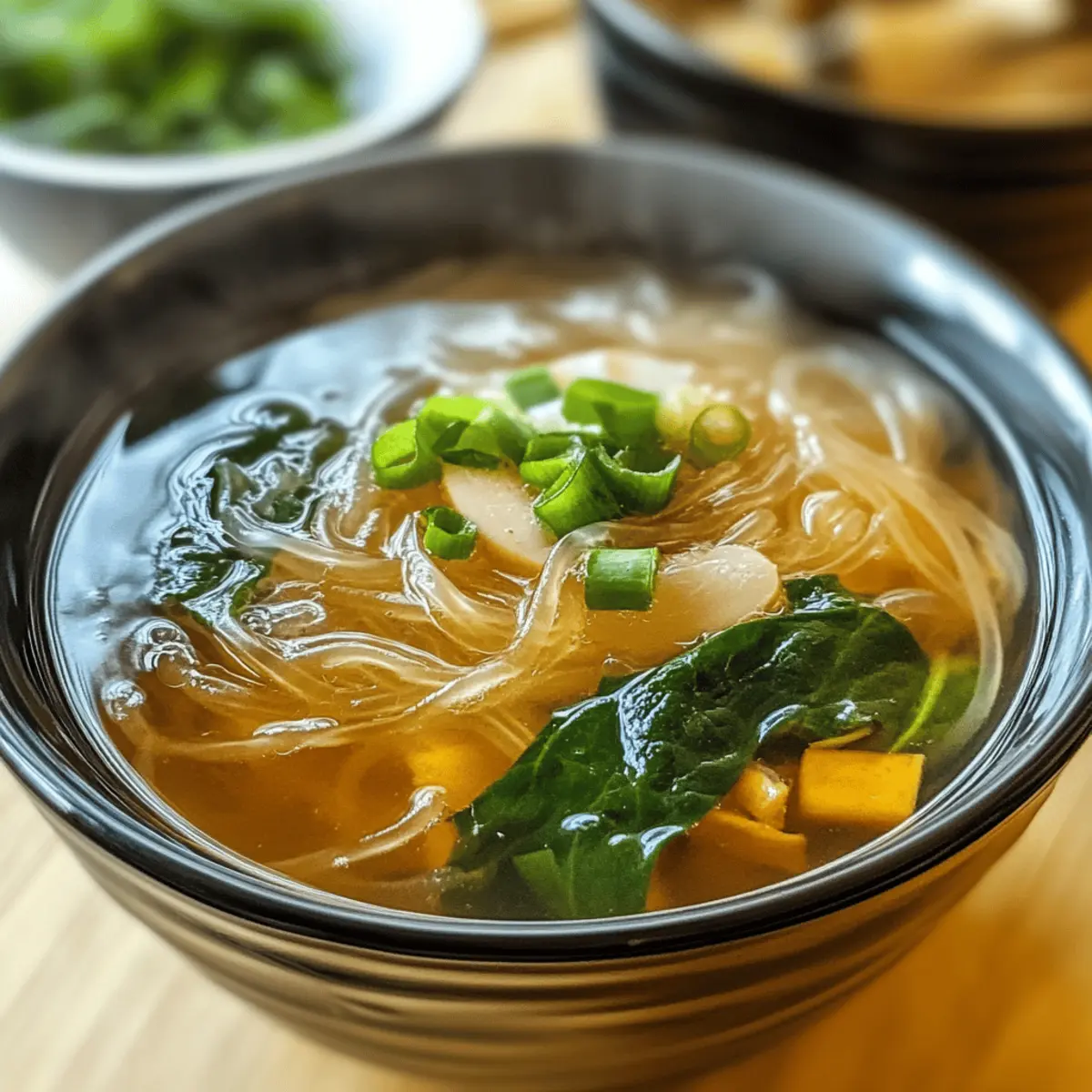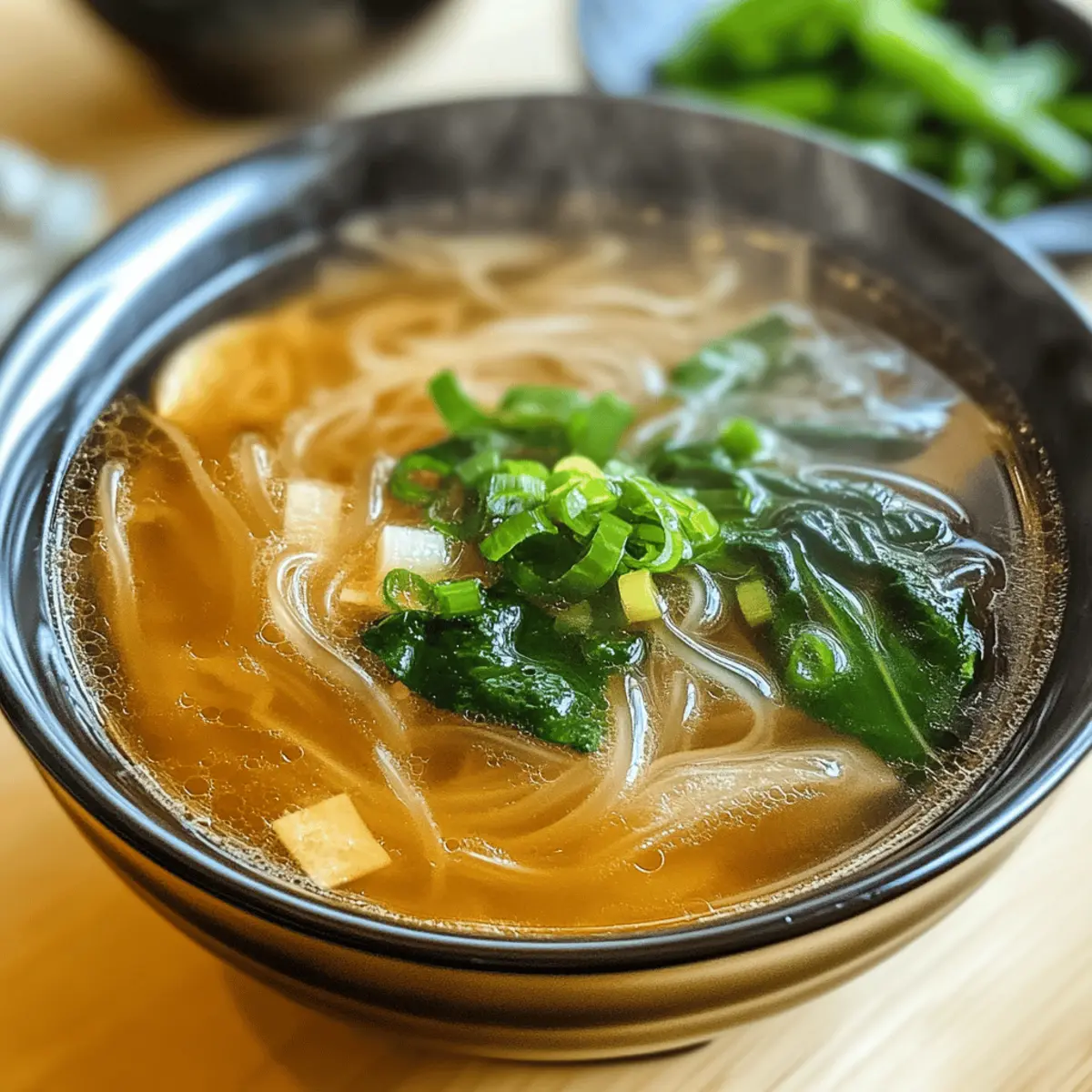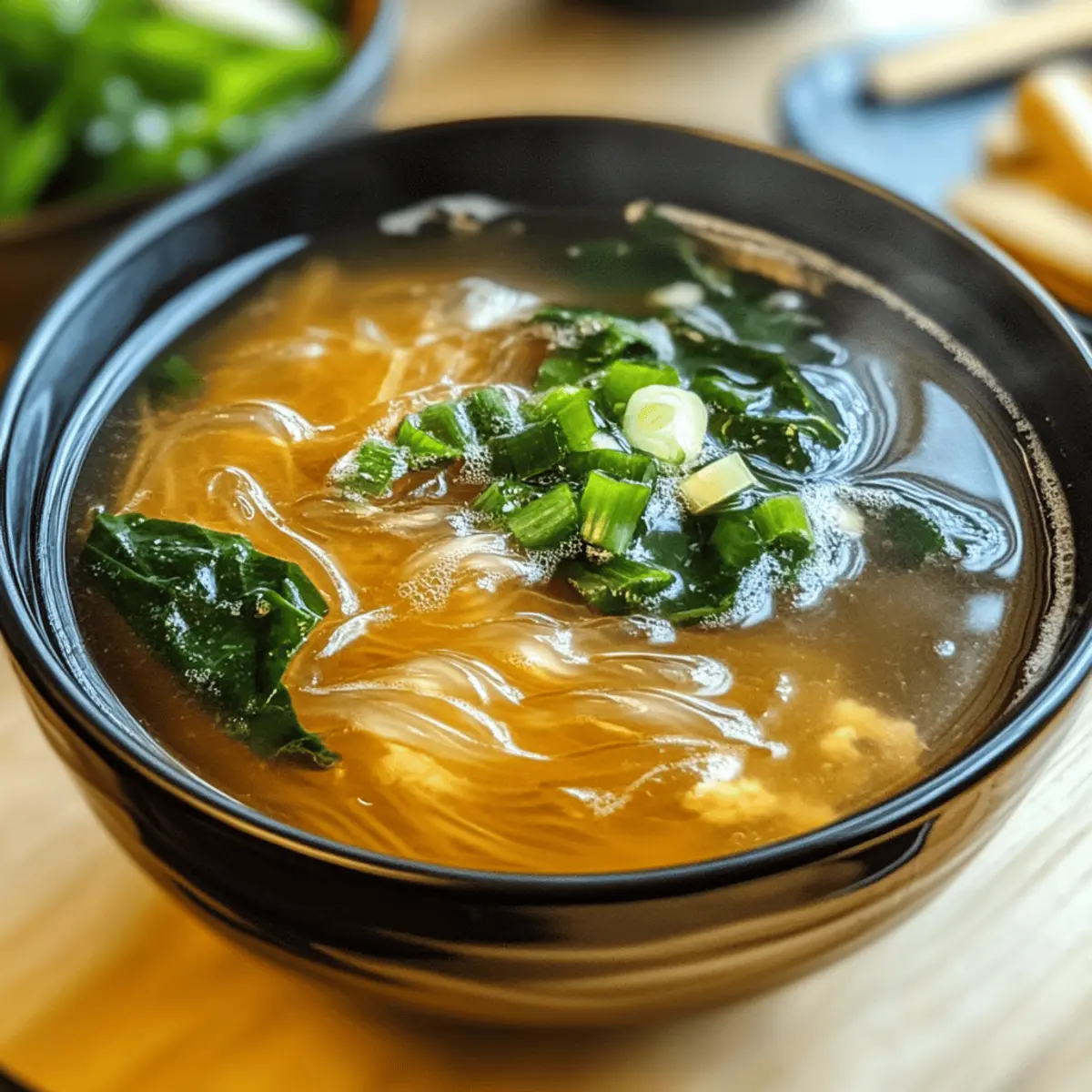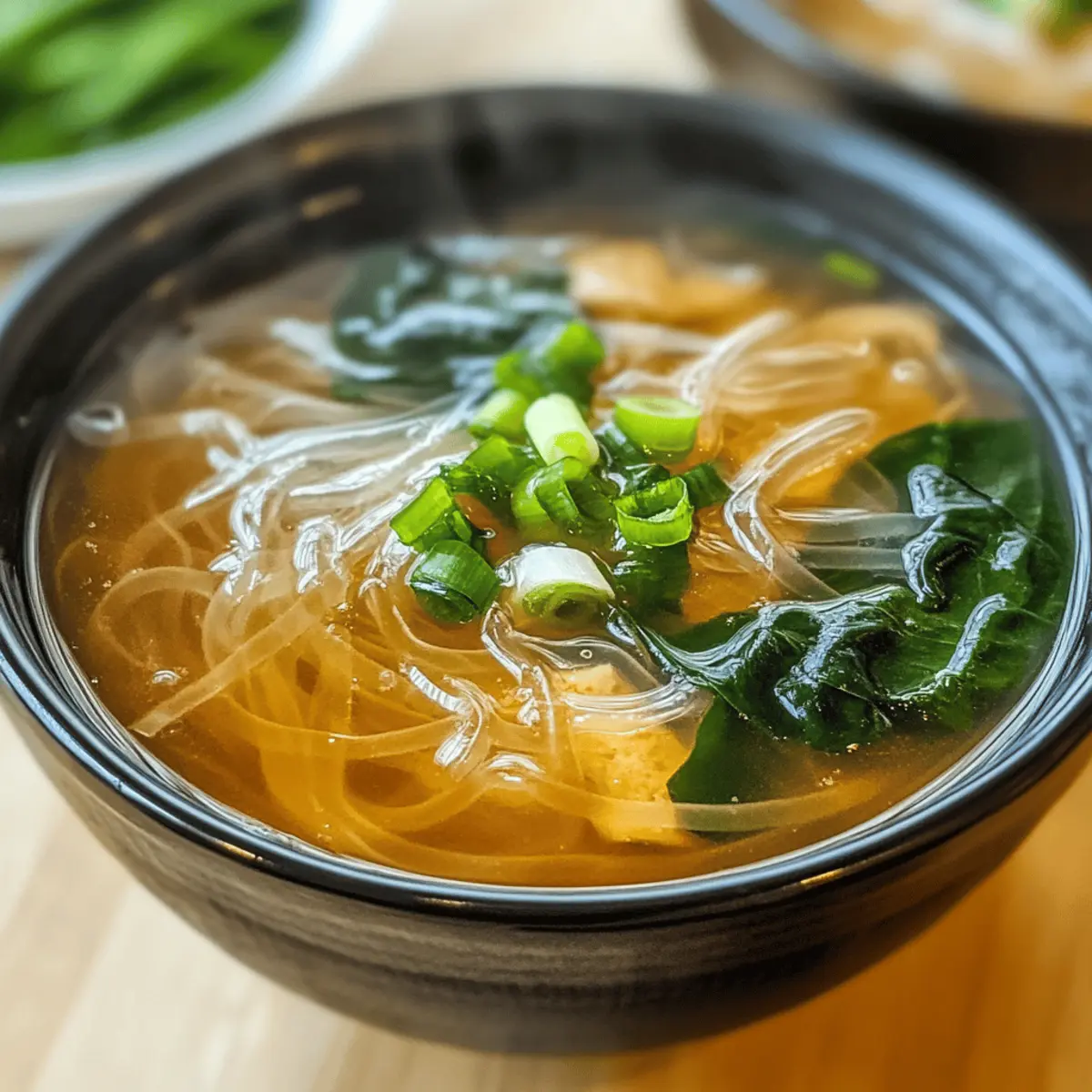As the chilly air wraps around me, I find myself craving something both warm and light—enter Japanese Glass Noodle Soup! This delicate Harusame Soup brings a wave of comfort with its translucent noodles swimming in a savory umami-rich broth. What I love most about this recipe is how incredibly customizable it is; whether you prefer a medley of colorful veggies or a heartier touch with tofu or shrimp, you can tailor this dish to your taste. Plus, it’s quick to whip up, making it perfect for those busy weeknights when all you want is a comforting bowl of goodness. Curious about how to make this deliciously light dish? Let’s dive into the world of Harusame!

Why is Glass Noodle Soup So Special?
Comforting Warmth: This Glass Noodle Soup embraces you with its warm, fragrant broth, perfect for chilly evenings.
Endless Customization: You can easily personalize it with your favorite vegetables or proteins—whether it’s tofu, chicken, or shrimp, there’s a combination for everyone.
Quick & Easy: It’s ready in under 30 minutes, making it a lifesaver on those busy weeknights when you crave comfort without the wait.
Nutritious Boost: Packed with fiber-rich vegetables, this dish is not just tasty but also a low-calorie, nutrient-dense option for anyone looking to eat healthier.
If you’re exploring more soothing soup ideas, don’t miss out on our delicious Cauliflower Chicken Soup or the flavorsome Pumpkin Veggie Soup!
Glass Noodle Soup Ingredients
• Discover the essentials for this deliciously warm dish!
For the Broth
- Dashi – The traditional Japanese soup stock that delivers an umami punch, or swap for vegetable broth to keep it vegetarian.
- Soy Sauce – Adds saltiness and depth; tamari can be used for a gluten-free alternative.
- Mirin – This sweet rice wine balances flavors perfectly; substitute with a mix of white wine and sugar if needed.
- Sesame Oil – A little goes a long way in introducing a nutty aroma; optional but highly recommended.
For the Noodles and Veggies
- Glass Noodles – The star of the show, these fine noodles absorb the broth’s flavors beautifully. Look for them in Asian grocery stores.
- Vegetables (e.g., mushrooms, spinach, green onions) – Contributes nutrition and a splash of color; use fresh greens or any mushrooms you love for added texture.
For the Protein (Optional)
- Tofu – A fantastic vegetarian choice that adds heartiness to the soup.
- Chicken or Shrimp – These options provide a boost of flavor and satisfaction for meat lovers.
Get ready to enjoy your comforting bowl of Glass Noodle Soup!
Step‑by‑Step Instructions for Glass Noodle Soup
Step 1: Prepare the Broth
In a medium pot, combine 4 cups of dashi, 2 tablespoons of soy sauce, 1 tablespoon of mirin, and 1 teaspoon of sesame oil. Set the heat to medium and bring the mixture to a gentle simmer, allowing the flavors to meld together for about 5 minutes. Keep an eye on the pot; you want the broth to be fragrant and just starting to bubble without boiling vigorously.
Step 2: Cook the Glass Noodles
Once your broth is simmering, add 4 ounces of glass noodles directly to the pot. Stir gently and let them cook according to the package instructions, which usually takes about 3 to 5 minutes. Watch for the noodles to become tender yet still slightly chewy, soaking up that delicious broth as they cook.
Step 3: Add Vegetables and Protein
After the glass noodles are cooked, toss in your choice of vegetables—like sliced mushrooms, spinach, and chopped green onions—and your protein, whether it’s cubed tofu, cooked chicken, or shrimp. Stir everything together, and let it simmer for an additional 3 to 5 minutes until the vegetables are vibrant and tender.
Step 4: Season and Serve
Taste your soup before serving, and adjust the seasoning if needed. You can add a splash more soy sauce for saltiness or a drizzle of sesame oil for aroma. Ladle the warm glass noodle soup into bowls, garnishing with additional green onions or sesame seeds for a lovely finishing touch. Enjoy this comforting dish while hot!

Make Ahead Options
Preparing Japanese Glass Noodle Soup ahead of time is a wonderful way to save precious moments during busy weeknights! You can prep the broth—combining dashi, soy sauce, mirin, and sesame oil—up to 24 hours in advance and store it in the refrigerator for maximum flavor. Additionally, chop your choice of vegetables and protein (like tofu or shrimp) ahead; they can be kept fresh for up to 3 days. When ready to serve, simply reheat the broth, add the glass noodles, and toss in the prepped vegetables and protein, cooking until heated through. This method ensures your Glass Noodle Soup remains just as delicious and comforting, making meal prep a breeze!
How to Store and Freeze Glass Noodle Soup
Fridge: Store the soup in an airtight container for up to 3 days. The noodles may absorb the broth over time, so consider adding a little water before reheating to restore consistency.
Freezer: You can freeze the broth separately from the noodles for up to 2 months. This keeps the noodles from becoming mushy when thawed.
Reheating: To reheat, gently warm the broth on the stove until simmering, then add the cooked noodles and any additional veggies. Heat through and serve immediately for the best flavor.
Make-Ahead Tip: If you plan to enjoy leftovers, cook the noodles fresh each time you want to eat the Glass Noodle Soup to maintain the best texture.
What to Serve with Japanese Glass Noodle Soup?
Serving up the perfect meal is all about balance and harmony, especially when you’re delighting in the warm embrace of a savory bowl of Harusame Soup.
-
Crispy Spring Rolls: The crunchy texture and fresh fillings of spring rolls offer a delightful contrast to the soft noodles, making each bite an adventure.
-
Steamed Edamame: These tender, buttery beans provide a light and healthy side that packs protein, complementing the soup’s flavors perfectly.
-
Asian Slaw Salad: A colorful mix of cabbage and carrots tossed in a sesame dressing not only adds freshness but also a delightful crunch to each mouthful.
-
Brown Rice: A hearty side of brown rice provides a nutty flavor while soaking up the rich broth of your soup—a comforting pairing you’ll adore.
-
Toasted Garlic Bread: For a bit of indulgence, pair with garlic bread to dip in the broth; it’s a fun and tasty contrast to the lighter soup.
-
Chilled Sake: Enjoying a chilled glass of sake can elevate your dining experience, enhancing the Umami flavors of the Harusame Soup.
These delightful pairings offer a variety of textures and tastes, creating a cozy meal perfect for any occasion. Enjoy your warm bowl!
Glass Noodle Soup Variations
There’s no limit to how you can personalize this comforting dish, inviting a tapestry of flavors and textures into your bowl!
-
Vegetable Medley:
Toss in vibrant greens like bok choy or napa cabbage for extra crunch and freshness. This adds lovely color as well. -
Spicy Twist:
Spice things up by adding chili paste or red pepper flakes. Perfect for those chilly days when you want something with a kick! -
Protein-packed:
Swap in shredded chicken or sautéed shrimp for a heartier soup. These proteins pair beautifully with the delicate noodles. -
Mushroom Broth:
Use a rich mushroom broth in place of dashi for an earthy flavor. It deepens the umami notes while staying vegetarian-friendly. -
Noodle Swap:
Replace glass noodles with rice vermicelli for a different texture. Each bite will still soak up that flavorful broth perfectly. -
Herb Infusion:
Add freshly chopped herbs like cilantro or basil right before serving. They’ll give a burst of freshness to your warm bowl of comfort. -
Sweet Touch:
Experiment by adding a splash of coconut milk for a subtle sweetness and creaminess. This twist brings a tropical feel to your meal. -
Umami Booster:
Stir in a spoonful of miso paste for extra depth. It amplifies the rich umami flavors that make this soup so comforting.
For more delightful soup ideas, I highly encourage you to try out our delicious Cauliflower Chicken Soup and the flavorsome Pumpkin Veggie Soup!
Expert Tips for Glass Noodle Soup
-
Don’t Overcook Noodles: Keep a close watch on the glass noodles; overcooking turns them mushy. They should be tender yet maintain a slight chewiness for the perfect texture.
-
Customize Wisely: Feel free to mix and match vegetables! However, be mindful of cooking times; hard veggies like carrots need longer than softer ones like spinach.
-
Umami Balance: If you prefer a stronger depth of flavor, add a dash more soy sauce or a bit of miso paste to your broth—this enhances the umami in your Glass Noodle Soup.
-
Broth Infusion: For the most flavorful broth, let it simmer for longer if you have time. The flavors deepen beautifully, making each spoonful more satisfying.
-
Storage Tips: If you’re making this ahead, store the broth and noodles separately; together, they can soak up too much liquid and become soggy.

Glass Noodle Soup Recipe FAQs
What type of glass noodles should I use?
Look for fine, translucent glass noodles, typically made from mung bean starch or sweet potato starch, in Asian grocery stores. They’re the star of the dish and will absorb all the delicious flavors of the broth.
How should I store leftover glass noodle soup?
Store the soup in an airtight container in the refrigerator for up to 3 days. Keep in mind that the noodles will absorb the broth over time, so you might need to add a splash of water when reheating to regain its original consistency.
Can I freeze glass noodle soup?
Absolutely! I recommend separating the broth from the noodles before freezing. Store the broth in an airtight container for up to 2 months. The glass noodles can become mushy when thawed, so it’s best to cook them fresh each time you enjoy a bowl.
What if my glass noodles are overcooked?
If you overcook the noodles, they may become mushy and lose their pleasing texture. To avoid this in the future, keep a close eye on the cooking time, aiming for that tender but still slightly chewy texture. If it happens, don’t worry—just add more veggies or protein for balance!
Is this recipe suitable for vegetarian diets?
Yes! This Glass Noodle Soup can be made vegetarian by using vegetable dashi or broth instead of fish-based dashi. You can also load it up with fresh vegetables and tofu for a heartier meal while enjoying all those lovely umami flavors.
Can I customize the vegetables in my glass noodle soup?
Very much so! Feel free to get creative with your choice of vegetables. Just remember that root vegetables, like carrots, take longer to cook than softer greens like spinach. Aim for a combination that suits your taste and offers a nice variety of colors and textures!

Deliciously Warm Glass Noodle Soup for Cozy Days
Ingredients
Equipment
Method
- In a medium pot, combine 4 cups of dashi, 2 tablespoons of soy sauce, 1 tablespoon of mirin, and 1 teaspoon of sesame oil. Bring to a simmer for about 5 minutes.
- Add 4 ounces of glass noodles to the pot and cook according to package instructions, about 3 to 5 minutes.
- Add choice of vegetables and protein. Let it simmer for an additional 3 to 5 minutes.
- Taste and adjust seasoning. Serve warm, garnished with green onions or sesame seeds.

Leave a Reply